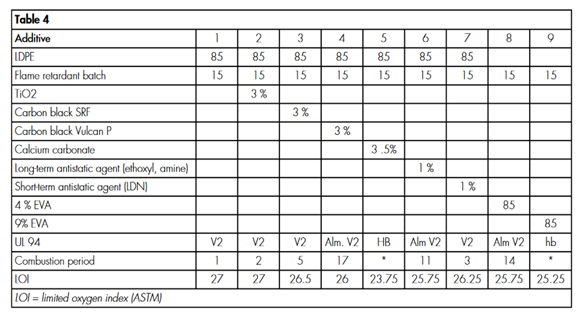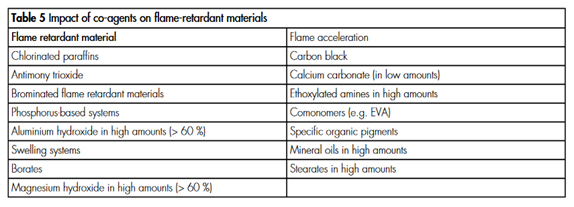
FLAME RETARDANT PLASTICS: A GENERAL REVIEW
Flame retardant plastics play an important role in our society
FLAME-RETARDANT FINISHING OF COTTON FABRIC
DEVELOPMENT OF FLAME RETARDANTS
INTRODUCTION TO DIOCTYL ADIPATE (DOA)
FIRE RETARDANT ADDITIVES FOR ABS, PC, HIPS
1. INTRODUCTION
Flame retardant plastics play an important role in our society. They are used in cases where there is are quirement to protect humans and property from a possible fire hazard. Together with other decisive fire prevention measures, such as structural design and the use of smoke detectors, the choice of materials is one of the basic decisions to be taken by the developers and manufacturers of plastic parts. In 1977, about 2.2billion US dollars were spent on flame retardant materials, accounting for 27 % of the plastic additives on the market (Figure 1)
There are numerous possible applications for flame retardant materials. For historical reasons, national fire protection and safety laws specify which types of flame retardant materials are to be used in each particular case.

Figure 1 Worldwide market shares of thermoplastic additives(1997: 8.5 billion USA dollars)
Attempts have been made for several years to harmonise the standards on flame retardant systems and to publicise and produce environmentally friendly products. The paper is intended to provide an overview of the most commonly used flame retardant systems and to describe in particular the contribution of the Resinex product range in this field.
2. CATEGORIES OF FLAME RETARDANTMATERIALS
The type of flame retardant material to use is determined not only by the required flame resistance standard and the physical dimensions for the particular application in question, but also by the class of polymers used. In order to differentiate between the material compositions used for flame retardant materials, we will start with a short discussion of the different types of plastic. This will be followed by a brief overview of the different types of flame retardant materials and the respective active mechanisms used to obtain the required flame resistance standard values.
2.1. Flame resistant polymers
There are two main polymer families:
- thermoplastics
- thermosetting plastics
This article deals with the use of flame retardant master batches or substance mixtures in thermoplastics. With thermoplastics, flame retardant substances are added to the polymer matrix in molten state during extrusion, while with thermosetting plastics, the flame retardant materials are incorporated in the polymer structure by means of polycondensation or grafting. Thermoplastics may be further divided into two important classes:
- amorphous polymers
- crystalline polymers
Table 1 lists a few examples of polymer types.

It is generally harder to endow crystalline polymers with retardant properties than it is amorphous resins.
2.2. Applications
Thermoplastics provided with flame retardant additives may be used in a wide variety of applications:
- In electrical engineering
- In transportation
- In construction
- In industry
Each one of these segments of industry has established its own flame resistance standards and specifications over the past few decades, often with reference to local government regulations. As a result, every market segment has a large number of regulations and test procedures forcing material developers to adapt their formulations to match customer requirements in order to meet the safety legislation of each individual German Land. Currently, attempts are being made to harmonise these flame resistance standards.
Table 2 lists a few examples of these flame resistance standards.

2.3. Mechanism of flame retardancy
Flame retardant materials may be divided into different categories in accordance with the different ways in which they interact with polymers. The interactions consist in the following:
- Chemical action
Certain flame retardant substances inhibit the formation of radicals which would otherwise form during the combustion process. The active mechanism in this case may be described briefly as follows: In a first phase, there is a heating process resulting in an increase in the temperature of the polymer. The polymer softens or melts and starts to flow away from the flame front resulting in the formation of burning droplets. In a second phase, the material breaks down into fragments with a lower molecular weight. The combustible gases formed ignite in the presence of a sufficient quantity of oxygen (phase 3) and combustion commences. At a certain time, the heat generated by the combustion becomes so high that the complete environment goes up in flames (resulting in sudden flame propagation). From this point on, the fire is uncontrollable. The main function of flame retardant materials is to prevent or at least delay the occurrence of this special sudden flame propagation. In the time interval between the ignition and the sudden flame propagation, people may be evacuated or, under some circumstances, the fire may even be extinguished.
- Physical action:
Other flame retardant substances cool the heated polymer structure down or form a protective layer on the surface of the heated polymer. A few flame retardant materials combine a physical and chemical reaction to achieve the required flame retardant properties.
Table 3 is an overview of the more significant product classes, the amounts added to meet the requirements of a special flame resistance standard and their main advantages and/or drawbacks.

Figure 2 shows that halogen-containing flame retardant substances are considered to be the best flame retardant substances, followed by inorganic systems and then phosphorus-based systems.

Figure 2 Main families of flame retardant materials (values1997, in USD)
T/3International Polymer Science and Technology, Vol. 29, No. 2, 2002In addition to requirements relating to flame retardancy, it is also necessary to meet numerous requirements relating to other properties, for example:•UV resistance
- temperature resistance
- high impact strength
- high rigidity, etc.
A basic knowledge of the interactions between flame retardant substances and other additives is required. The following case study should help to explain the complexity of the choice to be made. A flame retardant film was to be UV-resistant, black and anti-static and at the same time have acceptable mechanical properties. This type of film is used, for example, in the German construction industry. The applicable flame resistance standard is B2 (in accordance with DIN 4102) and/or V2 (UL 94).
DISCUSSION
The formulation for the flame retardant material is determined by numerous parameters, for example;
- The size and dimensions of the specimen: thinner film, for example, meets the condition B2 in PP more readily than in PE where a higher degree of flame resistance is required. This is linked to the typical behave our of PP or PE under combustion conditions.
- The type of flame retardant material used in relation to the typical standard value for flame resistance required:V2 will meet requirement B1 to an extensive degree, VO will not necessarily meet requirement B1.
- Certain co-agents may improve flame retardant properties, others may impair them.
Table 4 shows the impacts of various additives on flame retardant properties as a sort of guideline. The additive under consideration is based on a chlorinated flame retardant, which is mainly used due to its low price, but which has the serious drawback of poor heat resistance. Another ground for serious concern is the aspect of toxicity. As a general rule, the interaction of the additives listed in this table may be extrapolated to other flame retardant materials, such as bromine-based substances. This table may be used to derive the conclusions shown in
Table 5 regarding the influence of additives on flame retardant properties. One important reason why these additives may have a negative impact on flame retardant properties is that their chemical structure inhibits the formation of halogen radicals. If these radicals are trapped before they are able to inhibit the material degradation process, there is a dramatic reduction in the efficacy of flame retardancy. Itis advisable in every case to carry out tests to guarantee the required properties.


3. MIXTURES OR MASTERBATCHES, RESINEXPRODUCTS
To achieve the required level of flame retardancy, it is necessary to achieve a certain metering accuracy. In addition, uniform dispersion of the flame retardant materials is most important for cost efficiency. Table 3 clearly shows that the amounts added may fluctuate from a very low level to a very high level depending upon the required flame resistance standard value and the type of polymer used. If the amount of additive is so high that it is impossible to use a masterbatch or concentrate, mixtures have to be used. The advantage of working with a mixture is that itis possible to produce a finished resin with all the required properties, such as, for example, UV resistance, suitable coloration, high modulus of elasticity, etc. The drawback is that the concentration of the additives in question is prespecified and any corrections have to be introduced at the stage of the development of the formulation. Masterbatches are used in applications in which a high degree of dispersion of a low final concentration of flame retardant materials and/or other additives is required. Here, the advantage is that it is possible to make corrections to the concentration.
Table 6 is an overview of a few typical examples offered by Resinex for the application of masterbatches containing flame-retardant materials. More details are available on request.

4. FUTURE DEVELOPMENTS OF FLAMERETARDANT MATERIALS
Requirements for flame retardant materials in the future may be summarised as follows:
- Environmentally compatible products:
The doubts concerning the safe use of halogen-containing flame retardant materials in plastics mean it will be necessary to pay more attention to the toxicity and environmental compatibility of new products. As far as the price/performance ratio is concerned, halogen-containing materials are still the most cost effective products. Although intensive efforts are being made to develop flame-retardant materials, the more reputable manufacturers of brominated flame retardants are making serious efforts to develop safer products.
- Products conforming to the European harmonised fire resistance standard.
There may be problems with meeting the European Fire Protection Standard, for example the SBI standard compared with B1 (German Construction Standard)
- Price/performance ratio of the products.
Ideally, any new flame retardants should achieve at least the price/performance ratio of the halogenated systems currently available.
- Universal applicability.
Unlike halogen-free systems, halogen-containing systems may be universally applied in a wide range of plastics. This saves a significant amount of development costs both for producers and formulation developers.
Contact information:
MEGA VIETNAM
Office address: Floor 2-A2-IA20, Nam Thang Long Urban Area, Pham Van Dong Street,
Dong Ngac Ward, Bac Tu Liem District, Hanoi City, Vietnam
Tel: (+84) 24 375 89089; Fax: (+84) 24 375 89 098
Website: megavietnam.vn
Hotline: 1800.577.728 Zalo: 0971.023.523





